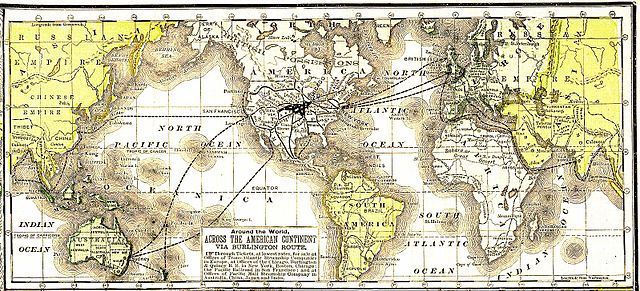Burlington and Missouri River Railroad
From Wikipedia, the free encyclopedia
The Burlington and Missouri River Railroad (B&MR) or sometimes (B&M) was an American railroad company incorporated in Iowa in 1852, with headquarters in Omaha, Nebraska. It was developed to build a railroad across the state of Iowa and began operations in 1856. It was acquired by the Chicago, Burlington and Quincy Railroad in 1872, and kept serving as its subsidiary.

History
Summarize
Perspective



The Burlington and Missouri River Railroad was incorporated in Burlington, Iowa in 1852. It commenced operations on January 1, 1856, with only a few miles of track. In 1857 it connected to Ottumwa, followed by Murray in 1868. It finally reached the Missouri River in November 1859. It used wood-burning locomotives and wooden passenger cars.[1]
After the Chicago, Burlington and Quincy Railroad (CB&Q) finished a bridge crossing the Mississippi River at Burlington, it connected to the Burlington and Missouri River Railroad.[1] By 1868 the Burlington and Missouri River Railroad operated 13 locomotives and 429 cars, mostly freight, with net earnings of $299,850 in 1867. After the interest on loans, this meant a total net profit of $6,749.[2]
A sub-branch of the railroad was founded in Nebraska in 1869,[1] with rails first entering the state in 1870 via Plattsmouth.[3] That summer, the railroad reached Lincoln, the recently designated state capital.[1] It later continued to lay rails westward and eventually joining with the Union Pacific Railroad on September 3, 1872, at Kearney; this had the effect of linking traffic from southern Nebraska to the rest of the continent.[3] That same year it began advertising "millions of acres of cheap land" as an incentive to prospective settlers to Iowa and Nebraska.[4]

The Burlington and Missouri River Railroad was acquired by the Chicago, Burlington and Quincy Railroad in 1872. At the time, it had begun laying tracks to Denver, Colorado; this line was finished by the CB&Q ten years later.[1]
After being acquired by the Chicago, Burlington and Quincy Railroad, the Burlington and Missouri River Railroad served as its subsidiary, operating several lines in the Black Hills, including those acquired when Chicago, Burlington and Quincy Railroad took over the Black Hills and Fort Pierre Railroad in 1901.[5]
See also
References
Further reading
Wikiwand - on
Seamless Wikipedia browsing. On steroids.
